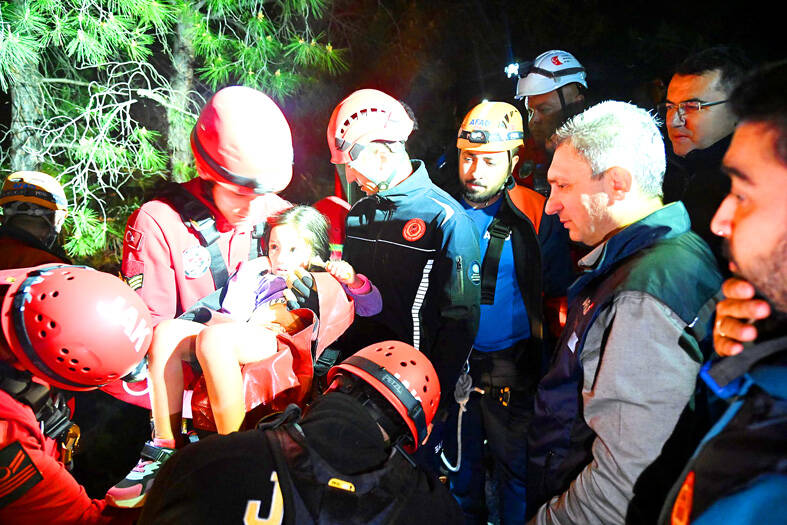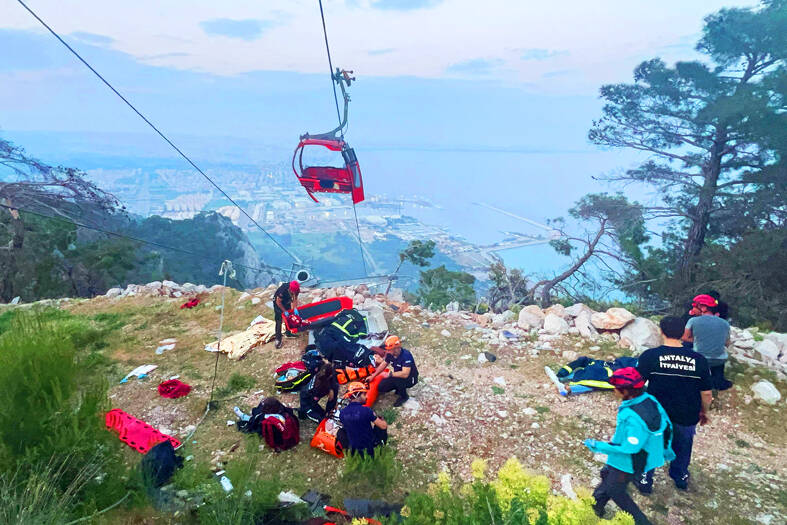One person was killed and 10 others were injured on Friday just outside the southern Turkish city of Antalya after a cable car cabin collided with a broken pole, the Turkish Ministry of the Interior said yeterday.
A total of 128 passengers were rescued from 16 cable cars, but 43 remained stranded in mid-air yesterday morning, the Turkish Disaster and Emergency Management Authority (AFAD) said.
Seven helicopters and more than 500 rescuers, including specialist mountaineers, were at the scene, authorities said.

Photo: Antalya Governorship via EPA-EFE
A video released by the Turkish Ministry of the Interior showed rescue personnel tied to safety ropes climbing into cabins.
Two children were among the injured in the accident, the state-run Anadolu Agency said.
Anadolu identified the deceased as a 54-year-old Turkish man.

Photo: Dia Images via AP
Images in Turkish media showed the battered car swaying from dislodged cables on the side of the rocky mountain as medics tended the wounded.
Friday was the final day of a three-day public holiday in Turkey marking the end of the Muslim holy month of Ramadan, which sees families flock to coastal resorts.
The cable car carries tourists from Konyaalti beach to a restaurant and viewing platform at the summit of the 618m Tunektepe peak. It is run by Antalya Metropolitan Municipality.
The cable car has 36 cabins with a capacity of six people each, and it takes an average of nine minutes to go uphill to the Tunektepe facility, information on its Web site says.
The Antalya Chief Public Prosecutor’s Office has launched an investigation. An expert commission including mechanical and electrical engineers and health and safety experts was assigned to determine the cause of the incident.

‘UNUSUAL EVENT’: The Australian defense minister said that the Chinese navy task group was entitled to be where it was, but Australia would be watching it closely The Australian and New Zealand militaries were monitoring three Chinese warships moving unusually far south along Australia’s east coast on an unknown mission, officials said yesterday. The Australian government a week ago said that the warships had traveled through Southeast Asia and the Coral Sea, and were approaching northeast Australia. Australian Minister for Defence Richard Marles yesterday said that the Chinese ships — the Hengyang naval frigate, the Zunyi cruiser and the Weishanhu replenishment vessel — were “off the east coast of Australia.” Defense officials did not respond to a request for comment on a Financial Times report that the task group from

Chinese authorities said they began live-fire exercises in the Gulf of Tonkin on Monday, only days after Vietnam announced a new line marking what it considers its territory in the body of water between the nations. The Chinese Maritime Safety Administration said the exercises would be focused on the Beibu Gulf area, closer to the Chinese side of the Gulf of Tonkin, and would run until tomorrow evening. It gave no further details, but the drills follow an announcement last week by Vietnam establishing a baseline used to calculate the width of its territorial waters in the Gulf of Tonkin. State-run Vietnam News

DEFENSE UPHEAVAL: Trump was also to remove the first woman to lead a military service, as well as the judge advocates general for the army, navy and air force US President Donald Trump on Friday fired the chairman of the Joint Chiefs of Staff, Air Force General C.Q. Brown, and pushed out five other admirals and generals in an unprecedented shake-up of US military leadership. Trump wrote in a post on Truth Social that he would nominate former lieutenant general Dan “Razin” Caine to succeed Brown, breaking with tradition by pulling someone out of retirement for the first time to become the top military officer. The president would also replace the head of the US Navy, a position held by Admiral Lisa Franchetti, the first woman to lead a military service,

Four decades after they were forced apart, US-raised Adamary Garcia and her birth mother on Saturday fell into each other’s arms at the airport in Santiago, Chile. Without speaking, they embraced tearfully: A rare reunification for one the thousands of Chileans taken from their mothers as babies and given up for adoption abroad. “The worst is over,” Edita Bizama, 64, said as she beheld her daughter for the first time since her birth 41 years ago. Garcia had flown to Santiago with four other women born in Chile and adopted in the US. Reports have estimated there were 20,000 such cases from 1950 to